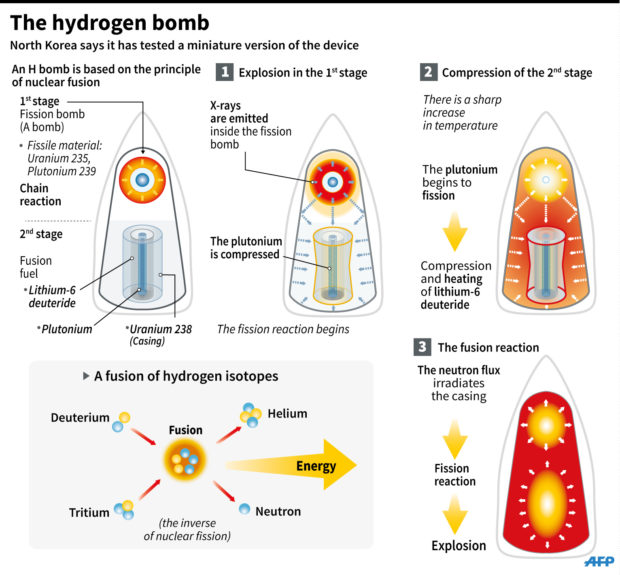North Korea has more powerful H-bomb — state media

SEOUL, South Korea — North Korea has developed a hydrogen bomb which can be loaded into the country’s new intercontinental ballistic missile, the official Korean Central News Agency claimed Sunday.
Questions remain over whether nuclear-armed Pyongyang has successfully miniaturized its weapons, and whether it has a working H-bomb, but KCNA said that leader Kim Jong-Un had inspected such a device at the Nuclear Weapons Institute.
It was a “thermonuclear weapon with super explosive power made by our own efforts and technology”, KCNA cited Kim him as saying, and “all components of the H-bomb were 100 percent domestically made”.
Pictures showed Kim in black suit examining a metal casing with two bulges.
North Korea triggered a new escalation of tensions in July, when it carried out two successful tests of an ICBM, the Hwasong-14, which apparently brought much of the US mainland within range.
It has since threatened to send a salvo of rockets towards the US territory of Guam, and last week fired a missile over Japan and into the Pacific, the first time it has ever acknowledged doing so.
US President Donald Trump has warned Pyongyang that it faces a rain of “fire and fury”, and that Washington’s weapons are “locked and loaded”.
After its fourth nuclear test, in January 2016, it claimed that the device was a miniaturized H-bomb, which has the potential to be far more powerful than other nuclear devices.
But scientists said the six-kiloton yield achieved then was far too low for a thermonuclear device.
When it carried out its fifth test, in September 2016, it did not say it was a hydrogen bomb.
The North had “further upgraded its technical performance at a higher ultra-modern level on the basis of precious successes made in the first H-bomb test”, KCNA said, adding that Kim “set forth tasks to be fulfilled in the research into nukes”.
Actually mounting a warhead onto a missile would amount to a significant escalation on the North’s part, as it would create a risk that it was preparing an attack.
UN sanctions –
The North Korean leadership says a credible nuclear deterrent is critical to the nation’s survival, claiming it is under constant threat from an aggressive United States.
It has been subjected to seven rounds of United Nations Security Council sanctions over its nuclear and ballistic missile programs, but always insists it will continue to pursue them.
Its first nuclear test was in 2006, and successive blasts are believed to have been aimed at refining designs and reliability as well as increasing yield.
The most recent detonation, in September last year, was its “most powerful to date” according to Seoul, with a 10-kiloton yield — still less than the 15-kiloton US device which destroyed Hiroshima in 1945.
Atomic or “A-bombs” work on the principle of nuclear fission, where energy is released by splitting atoms of enriched uranium or plutonium encased in the warhead, while hydrogen or H-bombs, also known as thermonuclear weapons, work on fusion and are far more powerful.
No H-bomb has ever been used in combat, but they make up most of the world’s nuclear arsenals.
Reports have suggested that it could soon carry out a sixth nuclear test, but the respected 38 North website said last week that satellite imagery of the Punggye-ri test site showed no evidence that a blast was imminent. CBB














